It’s Time for us
BIRDING IN
LADAKH
20-28
July 2024
ทิเบตน้อย แห่งอินเดีย


Ladakh is a region administered by India as a union territory and constitutes an eastern portion of the larger Kashmir region that has been the subject of a disputebetween India and Pakistan since 1947 and India and China since 1959. Ladakh is bordered by the Tibet Autonomous Region to the east, the Indian state of Himachal Pradesh to the south, both the Indian-administered union territory of Jammu and Kashmirand the Pakistan-administered Gilgit-Baltistan to the west, and the southwest corner of Xinjiang across the Karakoram Pass in the far north. It extends from the Siachen Glacier in the Karakoram range to the north to the main Great Himalayas to the south. The eastern end, consisting of the uninhabited Aksai Chin plains, is claimed by the Indian Government as part of Ladakh, and has been under Chinese control since 1962.
 |
| Siachen Glacie |
ลาดัก เป็นภูมิภาคหนึ่งของอินเดียซึ่งบริหารงานในสถานะเป็นเขตสหภาพ และถือเป็นพื้นที่ทางตะวันออกของแคว้นแคชเมียร์ ซึ่งเป็นประเด็นพิพาทระหว่างอินเดียและปากีสถานตั้งแต่ปี พ.ศ. 2490 กับอินเดียและตั้งแต่ปี พ.ศ. 2502 กับจีน ลาดักห์ล้อมรอบด้วยเขตปกครองตนเองทิเบตทางทิศตะวันออก, รัฐหิมาจัลประเทศของอินเดียทางตอนใต้, ทิศตะวันตกติดดินแดนสหภาพชัมมูและแคชเมียร์ที่ปกครองโดยอินเดีย และกิลกิต-บัลติสถานซึ่งปกครองโดยปากีสถาน
ทิศเหนือติดกับมุมตะวันตกเฉียงใต้ของซินเจียงพาดผ่านช่องเขาคาราโครัม ทอดยาวจากธารน้ำแข็ง Siachen ทางเหนือของเทือกเขาคาราโครัมไปจนถึงทางทิศใต้ของเทือกเขาหิมาลัย ปลายด้านทิศตะวันออกประกอบด้วยที่ราบ Aksai Chin ที่ไม่มีคนอาศัยอยู่ถูกรัฐบาลอินเดียอ้างสิทธิ์โดยเป็นส่วนหนึ่งของลาดัก และอยู่ภายใต้การควบคุมของจีนมาตั้งแต่ปี 1962
 |
| Karakoram |
The Architecture of Shanti Stupa, Leh
The Buddhist stupa serves as a landmark for the sacred space that represents the great Gautam Buddha's burial mound, and India has some of the oldest stupas in Buddhist culture. The architecture of Chantis Stupa mimics the architecture of a much older stupa. Its architectural style is very different from typical Ladakh architecture, making it a unique and popular attraction in the region.
สถูปพุทธทำหน้าที่เป็น แลนด์มาร์ค สำหรับพื้นที่ศักดิ์สิทธิ์ซึ่งแสดงถึงเนินฝังศพของพระโคตมพุทธเจ้า และอินเดียมีสถูปที่เก่าแก่ที่สุดบางแห่งในวัฒนธรรมทางพุทธศาสนา สถาปัตยกรรมของเจดีย์ Chantis เลียนแบบสถาปัตยกรรมของเจดีย์ที่มีอายุมากกว่ามาก รูปแบบสถาปัตยกรรมของมันแตกต่างจากสถาปัตยกรรมลาดักทั่วไปอย่างมาก ทำให้เป็นสถานที่ท่องเที่ยวที่มีเอกลักษณ์และได้รับความนิยมในภูมิภาค
To reach Chantis Stupa, climb 500 steps and you will find Buddhist cairns on both sides. The structure is milky white; the height is two stories, and there is a dome at the top. The dome, or mound, is reminiscent of the earthen mound used to cover the remains of the Buddha. The square railing at the top of the dome shows the fence around the hill and is a sign of a sacred place. Above the square building is a central pillar with an umbrella. This is called "Chatra" and represents the fulcrum of the universe where God ascends from heaven and becomes accessible to humankind. The walls of Chantis Tuppa are painted with colourful reliefs depicting the milestones of Gautam Buddha's life, including his birth, the fight against the devil, victory over injustice, and death. Inside, there is a huge meditation hall where you can sit, chant the Lord's name, meditate, and find peace of mind.
ในอดีต ลาดักได้รับความสำคัญจากที่ตั้งทางยุทธศาสตร์ตรงทางแยกของเส้นทางการค้าที่สำคัญ แต่เมื่อทางการจีนปิดพรมแดนระหว่างเขตปกครองตนเองทิเบตและลาดักในปี 1960 การค้าระหว่างประเทศก็ลดน้อยลง ตั้งแต่ปี 1974 รัฐบาลอินเดียประสบความสำเร็จในการส่งเสริมการท่องเที่ยวในลาดัก เนื่องจากลาดัคห์มีความสำคัญทางยุทธศาสตร์ กองทัพอินเดียจึงรักษาสถานะที่แข็งแกร่งในภูมิภาคนี้ไว้
เมืองที่ใหญ่ที่สุดในลาดักคือเลห์ ตามมาด้วยคาร์กิล ซึ่งแต่ละแห่งมีสำนักงานใหญ่ของเขต เขตเลห์ประกอบด้วยหุบเขาแม่น้ำสินธุ ชยอก และนูบรา เขต Kargil ประกอบด้วยหุบเขาแม่น้ำ Suru, Dras และ Zanskar พื้นที่ที่มีประชากรหลักคือหุบเขาแม่น้ำ แต่ทางลาดภูเขาก็ยังคงเอื้อประโยชน์ให้ชนเผ่าเร่ร่อนชาวช้างปาอีกด้วย กลุ่มศาสนาหลักในภูมิภาค ได้แก่ มุสลิม (ส่วนใหญ่เป็นชีอะห์) (46%) ชาวพุทธ (ส่วนใหญ่เป็นชาวพุทธในทิเบต) (40%) และฮินดู (12%) โดยส่วนที่เหลืออีก 2% เป็นศาสนาอื่น ลาดักเป็นหนึ่งในภูมิภาคที่มีประชากรเบาบางที่สุดในอินเดีย วัฒนธรรมและประวัติศาสตร์มีความเกี่ยวข้องอย่างใกล้ชิดกับวัฒนธรรมของทิเบต
LADAKH – Birding in the Cold Desert
“The Land is so barren and the passes so high that only our fiercest enemies or Our best friends would want to visit us” -Ladakhi Saying
Ladakh: Known as “The Moonland”, “Little Tibet” or more romantically “The Last Shangri-La”, is one of the most remote region of India, a barren, virtually rainless region. A desert in high altitude, has to be cold one. Due to rain shadow created by the mighty Himalayan range on one side and Karakoram Range on the other, monsoon clouds are denied to reach Ladakh & hence the cold desert. For water supply, Indus River is backbone of Ladakh, as the main source of water. Indus river is fed by the melting glaciers on the mountains. The mindblowing landscapes and the rugged mountains greet you as soon as you land in Leh, the capital of Ladakh. The mesmerizing beauty of this place has to be felt to believe.
ลาดัก: รู้จักกันในชื่อ "ดินแดนแห่งดวงจันทร์" "ทิเบตน้อย" หรือที่เรียกอีกชื่อหนึ่งว่า "แชงกรี-ลาแห่งสุดท้าย" เป็นภูมิภาคที่ห่างไกลที่สุดแห่งหนึ่งของอินเดีย พื้นที่แห้งแล้งและแทบไม่มีฝนตกชุก แน่นอนว่าทะเลทรายที่สูงก็ต้องหนาว ด้วยมีเทือกเขาหิมาลัยอันยิ่งใหญ่ด้านหนึ่งและเทือกเขาคาราโครัมอีกด้านหนึ่ง ได้บดบังไว้ทำให้เมฆมรสุม ไม่สามารถไปถึงลาดัคห์ได้ และด้วยเหตุนี้พื้นที่จึงเป็นทะเลทรายที่หนาวเย็น ในด้านแหล่งน้ำ แม่น้ำสินธุถือเป็นกระดูกสันหลังของลาดักซึ่งเป็นแหล่งน้ำหลัก แม่น้ำสินธุถูกหล่อเลี้ยงโดยธารน้ำแข็งที่กำลังละลายจากภูเขา ทิวทัศน์อันตระการตาและภูเขาอันขรุขระจะรอต้อนรับคุณทันทีที่มาถึงเลห์ เมืองหลวงของลาดัคห์ ความงามอันน่าหลงใหลของสถานที่แห่งนี้ต้องสัมผัสได้จึงจะเชื่อ
Ladakh has been explored by many tourists for sight seeing, Monastery, landscapes etc… but not much for Bird-watching… Ladakh lies between 3000 to 6000 mtrs, which obviously will have some very interesting high altitude birds that, otherwise are very difficult to see in rest of India. The rigours are extreme, but the rewards are equally lucrative….. Birding in this paradise is every birders dream and a photographers wish. Even an ordinary camera here can give you postcard quality images… so pure is the air and so magical is this place…..Its Spiritual, No wonder many come her repeatedly
นักท่องเที่ยวจำนวนมากมาเยือนลาดักห์เพื่อชมวิว อาราม ทิวทัศน์ ฯลฯ... แต่ไม่มากนักสำหรับการดูนก... ลาดักอยู่ระหว่าง 3,000 ถึง 6,000 เมตร ซึ่งเห็นได้ชัดว่าจะมีนกในระดับความสูงที่น่าสนใจมาก ที่จะเห็นได้ยากมากในส่วนอื่นๆของอินเดีย มีความยากลำบากมากๆ แต่ผลตอบแทนก็ให้ผลกำไรพอๆ กัน….. การดูนกในสวรรค์แห่งนี้คือความฝันของนักดูนกทุกคนและเป็นความปรารถนาของช่างภาพ แม้แต่กล้องธรรมดาๆ ที่นี่ก็สามารถให้ภาพคุณภาพระดับโปสการ์ดได้… อากาศบริสุทธิ์และสถานที่แห่งนี้ช่างมหัศจรรย์เหลือเกิน…..จิตวิญญาณ ไม่น่าแปลกใจเลยที่หลายๆ คนมาหาเธอซ้ำแล้วซ้ำเล่า
About Bird Watching in Ladakh
ลาดักเป็นบ้านของนกประมาณ 300 สายพันธุ์ และการดูนกอาจเป็นหนึ่งในสิ่งที่น่าตื่นเต้นมากมาย ส่วนใหญ่เป็นนกอพยพและพันธุ์อพยพที่ข้ามเทือกเขาหิมาลัยระหว่างการอพยพในฤดูใบไม้ผลิและฤดูใบไม้ร่วง
การดูนกในลาดักนั้นน่าตื่นเต้นมาก เพราะคุณจะได้เห็นนกนานาชนิดทั้งนกที่อยู่อาศัยและนกอพยพ ภูมิทัศน์ที่บริสุทธิ์ช่วยเสริมความงามของนกเหล่านี้ด้วย และสิ่งที่คุณได้รับคือประสบการณ์ที่น่าจดจำ
What are the different bird species found in Ladakh?
- Common Merganser
- Himalayan Griffon
- Golden Eagle
- Tibetan Snowcock
- Tibetan Partridge
- Eurasian Eagle Owl
- Snow pigeon
- Brown Dipper
- Winter Wren
- Alpine Accentor
- Jungle crow
- Eurasian Jackdaw
- Hume’s Groundpecker
- Black Drongo
- Eurasian Golden Oriole
- Common Starling
- Plain backed snowfinch
- Spanish Sparrow
- Bar tailed Treecreeper
- Yellowhammer
Where can bird species be spotted in Ladakh?
สายพันธุ์ผู้อพยพในลาดักมักพบเห็นได้ทั่วไปในลาดักตอนกลางและตะวันออก หากสภาพอากาศเปลี่ยนแปลงอย่างกะทันหัน ก็จะเห็นนกอพยพจำนวนมากขึ้นในพื้นที่ต่างๆ เช่น ภูมิภาค Hanle, Chumur, Tso Kar และ Shey-Tikse
สถานที่ดูนกที่มีชื่อเสียงในลาดัก ได้แก่ หุบเขา Suru, หุบเขา Nubra, บึง Shey, ทะเลสาบ Tso Moriri และอุทยานแห่งชาติ Hemis ภูมิภาคระหว่าง Sanko และ Parachik ในหุบเขา Suru มีชื่อเสียงในการพบนกหลากหลายสายพันธุ์ เช่น นกกระจิบหางขาว luscinia pectoralis และนกกระจิบชนิดต่างๆ ในพื้นที่รอบๆ อาราม Rizong เราสามารถมองเห็นนกนานาชนิด เช่น นกมุดน้ำสีน้ำตาลเหยี่ยวนกกระจอกใหญ่และWall Creeper การดูนกในลาดักสามารถเพลิดเพลินได้ที่หุบเขา Rumbak อุทยานแห่งชาติ Hemis หุบเขา Nubra ทะเลสาบ Tso Moriri และที่ราบ Tsokar
The following areas will be covered during our trip…natureindiatours@gmail.com
เดือน July เราจะมีโอกาศเจอแบบไหนนะตามหมายเหล่านี้
The Tso Kar is connected by an inlet stream at its south-west end to a small Fresh water lake, Startsapuk Tso, and together they form the 9 km2 More plains pool, which is dominated by the peaks of two mountains, Thugje (6050 m) and Gursan (6370 m).
Tso Kar เกิดจากการเชื่อมต่อกันด้วยลำธารทางเข้าทางตะวันตกเฉียงใต้และ Startsapuk Tso ทะเลสาบน้ำจืดขนาดเล็ก และเมื่อรวมกันแล้วจะกลายเป็นแอ่งที่ราบ More ขนาด 9 ตารางกิโลเมตร อยู่ท่ามกลางยอดเขาสองลูก Thugje (6050 ม. ) และกูร์ซาน (6370 ม.)
“Tsokar” means salty lake in local language. Here the water is alkaline. This is probably the best birding place in Ladakh… Famous for Tibetan Wild Ass & endangered Black-necked Cranes, this place is also known for breeding of Bar-headed Geese & Ruddy Shelducks….. other birds here include Horned Lark, Tibetan Snow Finch, Hume’s Groundpecker, Plain-backed Snowfinch, Twite, Streaked & Great Rosefinch, Northern Raven, Upland Buzzard, Little Owl, Tibetan Partridge, Tibetan Sandgrouse, Red-throated Pipit, Saker Falcon, Golden Eagle, Hill Pigeon, Brown Accentor, White-winged Redstart, Lesser & Common Kestrel, Bar-headed Geese, Brown-headed Gulls, Ruddy Shelducks etc…
Tso Kar เกิดจากการเชื่อมต่อกันด้วยลำธารทางเข้าทางตะวันตกเฉียงใต้และ Startsapuk Tso ทะเลสาบน้ำจืดขนาดเล็ก และเมื่อรวมกันแล้วจะกลายเป็นแอ่งที่ราบ More ขนาด 9 ตารางกิโลเมตร อยู่ท่ามกลางยอดเขาสองลูก Thugje (6050 ม. ) และกูร์ซาน (6370 ม.)
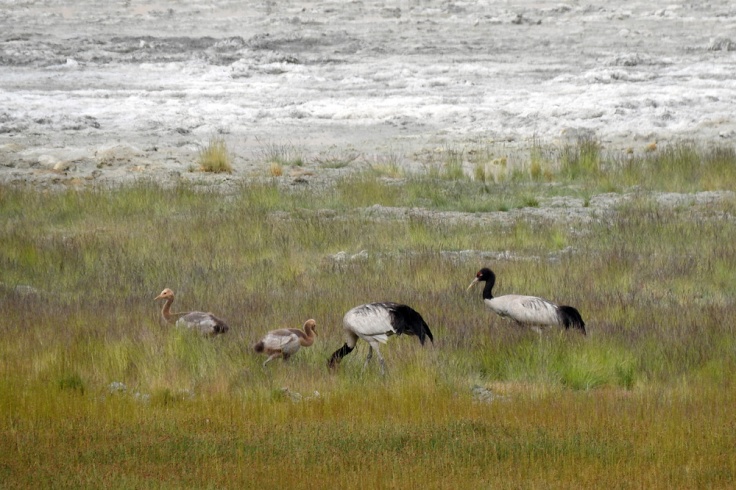
Tsokar” หมายถึงทะเลสาบเค็มในภาษาท้องถิ่น ที่นี่น้ำมีความเป็นด่าง เป็นที่นี่น่าจะเป็นสถานที่ดูนกที่ดีที่สุดในลาดัคห์… มีชื่อเสียงในเรื่องลาป่าทิเบตและนกกระเรียนคอดำที่ใกล้สูญพันธุ์ สถานที่แห่งนี้ยังขึ้นชื่อเรื่องการเพาะพันธุ์ Bar-headed Geese & Ruddy Shelducks…..
และนกอื่นๆรวมถึง Horned Lark, Tibetan Snow Finch, Hume’s Groundpecker, Plain-backed Snowfinch, Twite, Streaked & Great Rosefinch, Northern Raven, Upland Buzzard, Little Owl, Tibetan Partridge, Tibetan Sandgrouse, Red-throated Pipit, Saker Falcon, Golden Eagle, Hill Pigeon, Brown Accentor, White-winged Redstart, Lesser & Common Kestrel, Bar-headed Geese, Brown-headed Gulls, Ruddy Shelducks etc…
 |
| Red -front Serin |
 |
| Tibatan Sandgrouse |
Tsokar being the most important place for birds…..we shall see most of our birds here with 2 nights stay.
 |
| Tibetan Argali |
 |
| Himalayan Weasel |
 |
| Tibetan wild ass |
Hanle: It is an extensive marshland in Himalayas, situated at 4,500 mtrs (14,500 ft.)Another less explored place in Ladakh, Hanle is located in ancient Ladakh – Tibet trade route in Hanle valley. Known for Indian Astronomical Observatory & 17th century Hanle Monastery, is also home to birds like Black-necked Crane, Tibetan Lark, Upland Buzzard, Great Rosefinch, Hume’s Groundpecker & mammals like Tibetan Wild Ass, Tibetan Wolf, Red Fox, Tibetan Gazelle etc.
 Red Fox |
 |
| Tibetan wolf |
Pฮันเล: เป็นพื้นที่ลุ่มที่กว้างขวางในเทือกเขาหิมาลัย ตั้งอยู่ที่ความสูง 4,500 เมตร (14,500 ฟุต) อีกหนึ่งสถานที่ที่ไม่ค่อยมีคนสำรวจในลาดักห์ ฮันเลตั้งอยู่ในเส้นทางการค้าลาดัก - ทิเบตโบราณในหุบเขาฮันเล เป็นที่รู้จักจากหอดูดาวดาราศาสตร์อินเดีย และอาราม Hanle ในศตวรรษที่ 17 ยังเป็นที่อยู่ของนก เช่น Black-necked Crane, Tibetan Lark, Upland Buzzard, Great Rosefinch, Hume’s Groundpecker และสัตว์เลี้ยงลูกด้วยนม เช่น Tibetan Wild Ass หมาป่าทิเบต จิ้งจอกแดง ละมั่งทิเบต เป็นต้น
 |
| Hume’s groundpecker |
 |
| Upland Buzzard |


















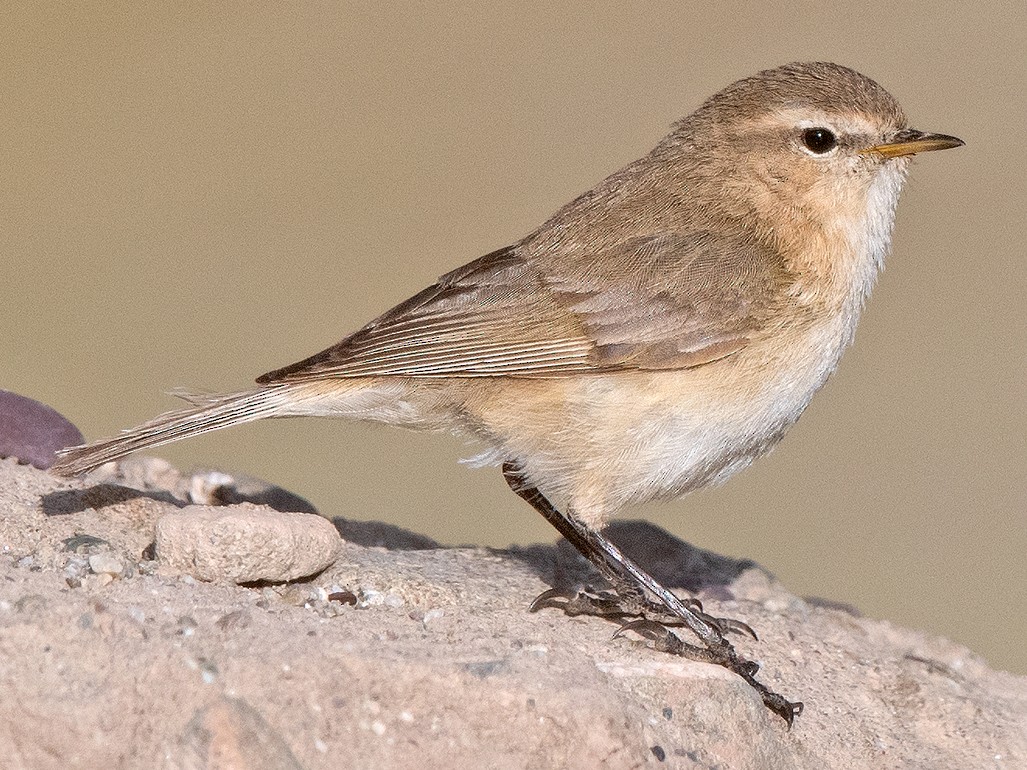

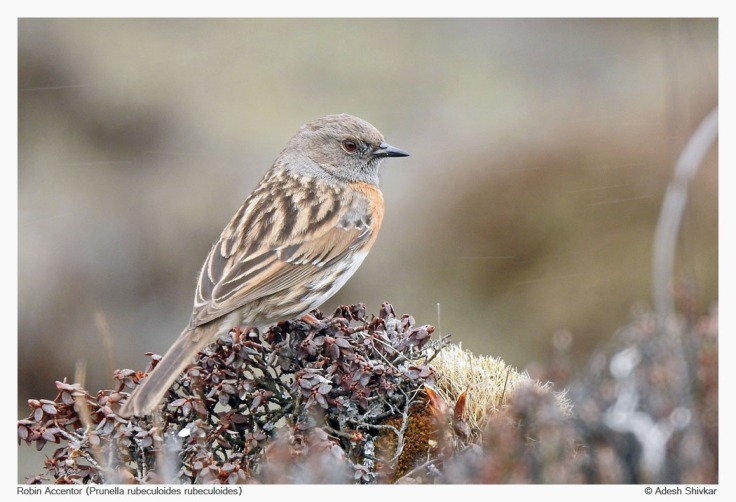







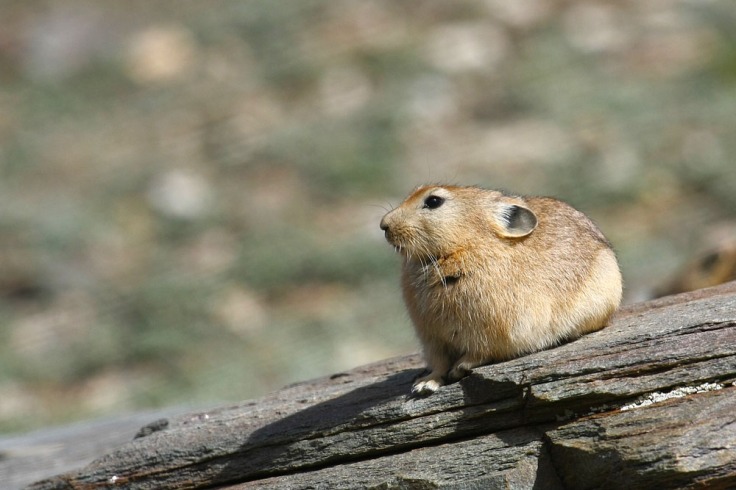








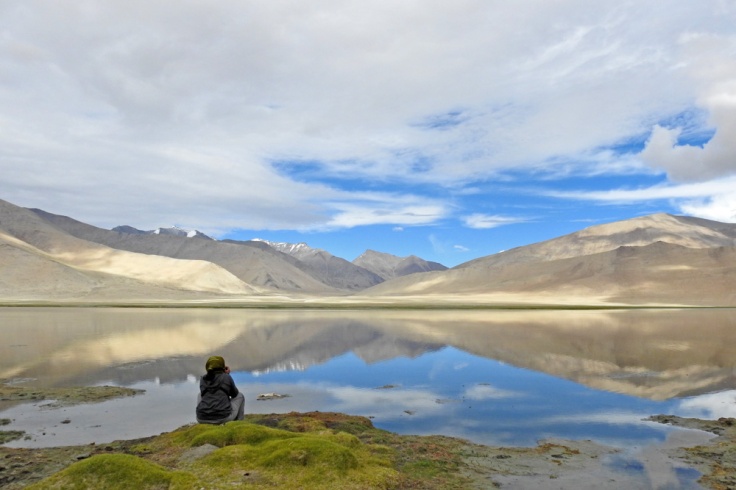






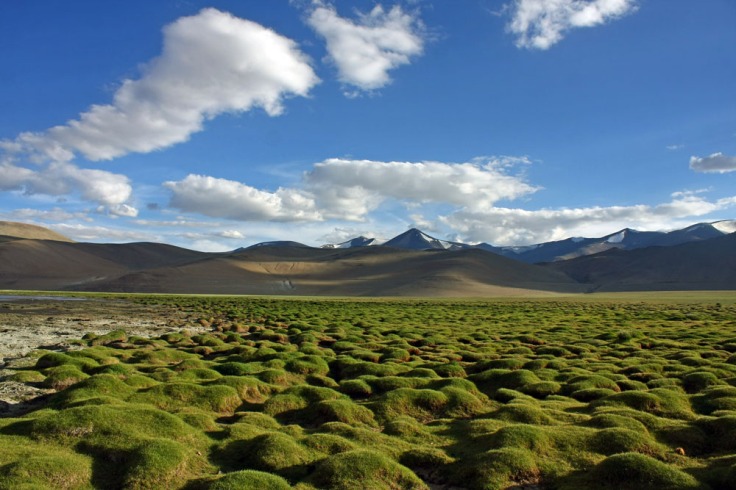
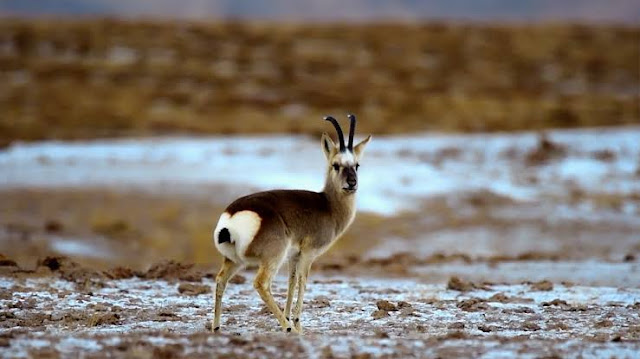







ไม่มีความคิดเห็น:
แสดงความคิดเห็น